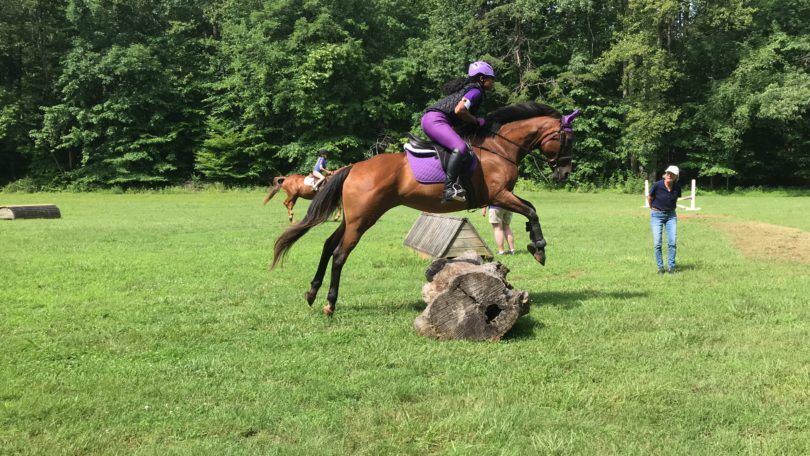If you want to school your horse over fences, you need to develop a correct, solid jumping position. This position, also called “two-point,” gets the rider’s seat out of the saddle and more forward over the horses’ shoulders.
In a nutshell, the correct jumping position features:
- Seat slightly out of the saddle.
- Balance forward in a “bent” position.
- Weight in your lowered heels.
- Hands forward in a “release” over the jump.
- Eyes up!
Thanks to Emily Harris for our feature photo!
 Be Patient with Yourself
Be Patient with Yourself
Following the horse’s center of gravity properly requires strength, balance, and timing. Generally, there is a progression to this learning process.
Start by learning a solid jumping position on the flat (i.e. no jumps), then slowly build up to practicing over ground poles and cross rails (i.e. small jumps). Once your position is solid, you can move on to practicing over larger jumps.
This process can take months, even years, depending on the individual rider and horse. That’s 100% OK!
Two-Point Explained
The two-point position gets its name from the rider’s weight distribution, which shifts from the seat (one point) to the feet (two points). This helps the rider’s body stay forward with shoulders aligned over their hands.
It’s important for the rider to develop an independent seat and not be reliant on the reins to stay balanced.
A proper jumping position also requires a shorter stirrup length.
Traditionally, the English stirrup should fall at the ankle bone when riding on the flat. To jump, however, the stirrup should fall above the ankle bone — generally 1-2 holes shorter than the rider’s normal stirrup length.
The lower leg must be solid and still, essentially locked into position with the heel down. This helps keep the rider out of the horse’s way (important) and in a more secure position.
Check out our 10 Best Stirrups for Jumping Clear (And Staying Safe).
A strong lower leg is essential for jumping if you want to stay on the horse!
Photo by Laila Klinsmann from Pexels
The jumping position involves more than just seat and lower leg. You’ll also need a strong core and balance.
The rider’s core includes abdominal muscles, as well as back muscles. The back should make a straight line from the shoulders to hips.
The rider’s head should be up, eyes forward — definitely not looking down at the horse or the jump.
Lastly, the rider’s hands should be in light contact with the horse’s mouth, able to release over the jump.
New to the sport? Check out our 26-Page Horse Rookie’s Guide to Jumping.
Tips to develop the perfect position:
- Practice, practice, practice: Spend as much time as possible working on your jumping position. This includes time in the saddle, both on the flat and over fences, and even time at the gym if you can’t get to the barn more frequently.
- Develop your core: Focus on exercises that improve core strength, as well as those that stretch the lower leg and allow the heel to sink deeper in the stirrup. Yoga is a great way to improve your riding out of the saddle—you’ll build core strength, stretch, and improve balance.
- Build muscle memory: Repeating jumping exercises, gymnastics like bounces and grids, help improve your form and develop muscle memory — for you and your horse. A riding instructor should be involved, especially if you’re a beginner over fences.
- Jump without reins: This should only be done on an experienced, safe horse and under the supervision of a riding instructor. Riding through a simple sequence of jumps without reins helps develop the independent seat and better balance.
- Watch and learn: Equestrian vloggers can be wonderful teachers. Watching their videos helps you understand proper position — and why it matters. Bonus: This is a great way to develop your eye for distances!
Over and Upward
Jumping can be fun, rewarding, and challenging. That’s why a solid two-point position is essential to make you safe, effective, and successful over fences.
P.S. Enjoy this article? Trot on over to:
- 10 Best Stirrups for Jumping Clear (And Staying Safe)
- Horse Jumping Position 101: How to Get It Right
- Compositi Stirrups Review: I’ve Never Jumped Better
- 100+ Things to Pack for a Jumping Horse Show (Checklist)
- When can (and should) you start jumping a horse?
- 4-Star Favorites: The 4 Best Cross Country Stirrups
- Horse Riding for Older Adults: Why It’s Never Too Late
- How Often to Replace Horseback Riding Helmets
References:
- https://www.fei.org/stories/improve-your-jumping-position-these-four-steps
- https://www.appliedpostureriding.com.au/horse-riding-posture/the-jumping-position-for-horse-riders
